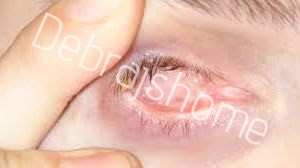Contracted Socket
What do you mean by a Contracted socket?
An Orbital Eye Socket, in which the eye is damaged or removed, is called an anophthalmic socket. Once an eye is removed, if a ball implant is not put in to replace the volume of the removed eye, the eye socket can become contracted.
A Contracted Socket is characterized by fibrosis of the anopthalmic orbital socket, with subsequent soft tissue volume loss, mucosal lining deficit and malposition of eyelids leading to varied degrees of disfigurement and inability to maintain an ocular prosthesis (artificial eye).
For some anophthalmic patients, the contracted socket is a severe problem that precludes the wearing of a prosthesis. A normal and cosmetically acceptable appearance is dependent on the ability of a socket to retain a prosthesis (false eye). The disfigurement and distress caused by the contracted socket and its inability to accommodate a prosthesis may have a profound detrimental effect on the patient’s career, self-esteem, and psychosocial interactions.
Causes of Contracted Socket
Majority of contracted socket cases are due to faulty technique of enucleation / evisceration surgery, infection, ill fitting prosthesis and not using ocular prosthesis, second major cases were of congenital origin (from birth).
Causes:
- Socket contracture classically takes place following evisceration or enucleation, particularly in the absence of an orbital implant, but may also occur in congenital anopthalmos.
- Radiation treatment (usually as treatment of the eye tumor that necessitated removal of the eye)
- Extrusion of an enucleation implant
- Severe initial injury (alkali burns or extensive lacerations)
- Poor surgical techniques (excessive sacrifice or destruction of conjunctiva and Tenon capsule; traumatic dissection within the socket causing excessive scar tissue formation)
- Multiple socket operations
- Removal of the conformer or prosthesis for prolonged periods
- It may be more lethal in cases of severe traumatic injury, previous reconstructive surgery, chemical burns, radiotherapy, active cicatrizing conditions, or chronic inflammation from an ill-fitting implant/prosthesis.
How severe is your Contracted Socket? Contracted Socket Severity Classification:
The soft tissue sockets are divided into five grades for the sake of convenience in management of contracted sockets.
Grade-0: Socket is lined with the healthy conjunctiva and has deep and well formed fornices.
Grade-I: Socket is characterized by the shallow lower fornix or shelving of the lower fornix. Here the lower fornix is converted into a downwards sloping shelf which pushes the lower lid down and out, preventing retention of an artificial eye.

Grade-II: Socket is characterized by the loss of the upper and lower fornices.
Grade- III: Socket is characterized by the loss of the upper, lower, medial and lateral fornices.

Grade-IV: Socket is characterized by the loss of all the fornices, and reduction of palpebral aperture in horizontal and vertical dimensions .
Grade-V: In some cases, there is recurrence of contraction of the socket after repeated trial of reconstruction surgery.
Contracted Socket Reconstruction Surgery
The technique of eye socket reconstruction surgery includes methods to deepen both the superior and inferior fornices. The main purpose of reconstructive surgery procedures is to allow the socket to maintain a prosthetic eye (artificial eye), which has a satisfactory cosmetic appearance and, if possible, good motility (good movement of the artificial eye).
Mucous membranesplit-thickness skin & dermis-fat grafts can be utilized for this purpose. In general, mucous membrane is more satisfactory. Techniques are now used whereby molded gutta-percha conformers and also plastic conformers support the mucous membrane graft.
The eye socket reconstruction is the recreation of the normal eye appearance in patients who have diseased eyes that require removal of the eye. It involves volume replacement with a spherical implant and the subsequent wear of a customized eye prosthesis that looks like the other eye.
Patients who have had an eye enucleated or removed may have socket related problems including:
- Deep superior sulcus deformity ie the eye looks sunken above the upper eyelid
- Shallow fornices ie the groove between the lids and the deeper tissues is too shallow to support an ocular prosthesis
- Sensitivity to the ocular prosthesis (false eye)
- Contracted socket (a more severe deficiency of volume and surface area which makes retention of an ocular prosthesis difficult)
Surgical Management of Contracted socket:
Following techniques are used:
- Prosthesis modification
- Fornix forming suture
- Mucous membrane graft
- Epidermal graft
- Dermis fat graft
- Artificial Socket Expanders